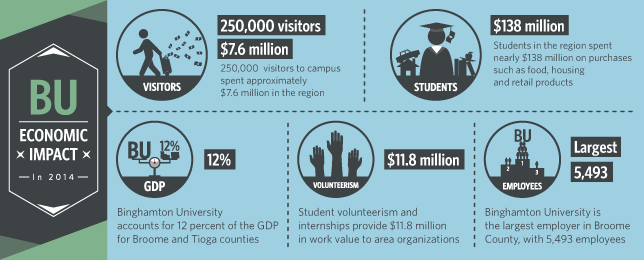
Going by the numbers, Binghamton University is a sizable economic force within the Southern Tier and a significant source of income for the local community.
According to the University’s Economic Impact Report, BU accounts for 12 percent of the total combined GDP of Broome and Tioga counties. The report claims that in 2014, the University’s total impact to New York State was $1.38 billion and that 11,500 jobs are directly or indirectly supported by this money.
Many Downtown businesses cite students as a large driver of their sales. When students are on break during the summer and winter months, businesses often suffer from a sharp drop in consumer spending.
“I would say that when the students are gone, my business goes down by 40 percent,” said Arif Shakel Ansari, owner of Taj Tandoor, a restaurant on the West Side of Downtown Binghamton.
At several Downtown locations, such as Elsie’s Diner and Sugar Mountain, there is a strong spike in student buyers at the beginning and end of semesters. As students move into new places, many businesses see an increase in student shoppers and a boost in sales. Overall, the University reported visitors to BU spent $7.6 million last year, and students contributed $96 million to the local community.
University President Harvey Stenger said that through initiatives such as the Small Business Development Center, which offers management assistance to startup or established local businesses for free, and the Entrepreneurship and Innovation Partnerships, the University has a pronounced positive effect on the local economy.
“Binghamton University has played an integral role in the local economy for decades, and we will continue to forge relationships with local businesses for the betterment of the city, the county and the state,” Stenger wrote in an email. “This year we were one of 18 universities in the country to be named an Innovation & Economic Prosperity University by the Association of Public and Land-grant Universities for our strong engagement with the local economy.”
According to a Broome Country economic report, BU is the largest employer in Broome County with 5,493 individuals employed. The University is slightly ahead of United Health Services, which employs 5,428 people.
Some students have mixed views of the offerings of Downtown enterprises. While many enjoy frequenting local establishments, others want more options.
“The businesses in the area do cater to students and I like to shop around town,” said Dominica Wolinski, a junior majoring in business administration. “But there could be more variety; it’s not as nice as some other places.”
Adam VanGuilder is the co-manager of Jabberwock, a Downtown smoke shop. He said the relationship between students and the local community has a long history that has been further complicated by Binghamton’s economic troubles.
“This is a proud post-industrial town, and we shouldn’t have to depend on the scraps of Long Island kids who have had everything handed to them,” VanGuilder said. “The students spend money here alright, but the only thing going up in the city is more student housing.”
Although the University is an economic boost to the city as a whole, there remains a divide between the benefits reaped by the city residents and the SUNY students.
“Every single aspect of the local economy is dependent on students,” said Kaelan Castetter, a Binghamton High School graduate and a sophomore majoring in political science. “Students show immense pride in their school, but it really doesn’t translate into pride for the city.”


